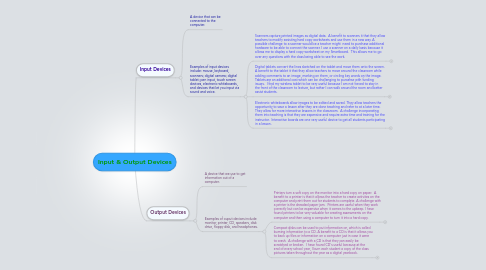
1. Input Devices
1.1. A device that can be connected to the computer.
1.2. Examples of input devices include: mouse, keyboard, scanners; digital camera; digital tablet; pen input, touch screen devices, electronic whiteboards, and devices that let you input via sound and voice.
1.2.1. Scanners capture printed images as digital data. A benefit to scanners it that they allow teachers to modify exsisting hard copy worksheets and use them in a new way. A possible challenge to a scanner would be a teacher might need to purchase additional hardware to be able to connect the scanner. I use a scanner on a daily basis because it allows me to display a hard copy worksheet on my Smartboard. This allows me to go over any questions with the class being able to see the work.
1.2.1.1. Scanner
1.2.2. Digital tablets convert the lines sketched on the tablet and move them onto the screen. A benefit to the tablet it that they allow teachers to move around the classroom while adding comments to an image, marking on them, or circling key words on the image. Tablets are an additonal cost which can be challenging to purcahse with funding issues. I find my wireless tablet to be very useful because I am not forced to stay in the front of the classroom to lecture, but rather I can walk around the room and better assist students.
1.2.2.1. Wireless Slate
1.2.3. Electronic whiteboards allow images to be edited and saved. They allow teachers the opportunity to save a lesson after they are done teaching and refer to at a later time. They allow for more interactive lessons in the classroom. A challenge incorporating them into teaching is that they are expensive and require extra time and training for the instructor. Interactive boards are one very useful device to get all students participating in a lesson.
1.2.3.1. Smartboard
2. Output Devices
2.1. A device that we use to get information out of a computer.
2.2. Examples of ouput devices include: monitor, printer, CD, speakers, disk drive, floppy disk, and headphones.
2.2.1. Printers turn a soft copy on the monitor into a hard copy on paper. A benefit to a printer is that it allows the teacher to create activites on the computer and print them out for students to complete. A challenge with a printer is the dreaded paper jam. Printers are useful when they work correctly but can be expensive when it comes to the upkeep. I have found printers to be very valuable for creating assessments on the computer and then using a computer to turn it into a hard copy.
2.2.1.1. Printer
2.2.2. Compact disks can be used to put information on, which is called burning information to a CD. A benefit to a CD is that it allows you to back up files or information on a computer just in case it were to crash. A challenge with a CD is that they can easily be scratched or broken. I have found CD's useful because at the end of every school year, I burn each student a copy of the class pictures taken throughout the year as a digital yearbook.
2.2.2.1. Compact Disk
